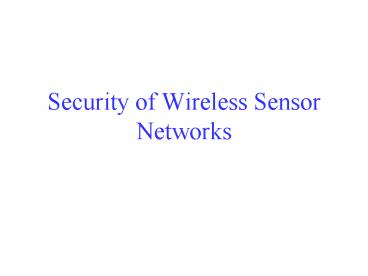Security of Wireless Sensor Networks - PowerPoint PPT Presentation
1 / 12
Title:
Security of Wireless Sensor Networks
Description:
Title: PowerPoint Presentation Last modified by: Dr. Sun Created Date: 1/1/1601 12:00:00 AM Document presentation format: On-screen Show (4:3) Other titles – PowerPoint PPT presentation
Number of Views:39
Avg rating:3.0/5.0
Title: Security of Wireless Sensor Networks
1
Security of Wireless Sensor Networks
2
Security Risks in Wireless Sensory Networks
- Eavesdropping
- Confidentiality
- Packet Injection
- Access control
- Integrity
- Jamming
- Replay
- Denial of Service
K
K
TinySec
K
K
Adversary
3
Security Goals
- Access Control
- Link layer protocol should prevent unauthorized
parties from participating in the network - Message Integrity
- Receiver should be able to detect the malicious
modification of transmitted messages - Confidentiality
- Keep transmitted messages secret from
unauthorized parties - Replay Protection
- Attacker can replay a legitimate message at some
later time
4
Security Goals
- Performance
- Using cryptography will incur increased overhead
in extra demands on the processor and RAM - Increased message length decreases the throughput
and increased latency. It will also increase the
power consumption - Ease of use
- Higher level security protocols will rely on the
link-layer security as a primitive - Transparent to applications
5
Security Primitives
- Message Authentication Codes (MACs)
- A common solution to achieve authenticity and
integrity - MAC can be viewed as Cryptographically secure
checksum - Generated with a key shared by both sender and
receiver - Difficult to forge without the key
- Initialization Vectors (IV)
- To achieve semantic security
- An input to the algorithm to add variation to the
encryption process
6
Block Ciphers
- Pseudorandom permutation (invertible)
- DES, RC5, Skipjack, AES
- Maps n bits of plaintext to n bits of ciphertext
- Used to build encryption schemes and message
authentication codes (MAC)
7
Mode of Operation
- Block ciphers operate on blocks of plaintext and
ciphertext - For example 64 bits
- A cryptographic mode combines the basic ciphers,
some sort of feedback, and some simple operations - Example Block Cipher modes
- ECB, CBC, CFB, CTR, OFB
8
Cipher Block Chaining (CBC) Mode
The results of the encryption of previous blocks
are fed back into the encryption of the current
block.
9
Two Security Options
- Authenticated Encryption (TinySec-AE)
- Data payload encrypted
- Packets authenticated with a MAC
- MAC computed over the encrypted data and the
packet header - Authentication Only (TinySec-Auth)
- Data payload is not encrypted
10
Encryption
- TinySec IV format
- Tradeoff between long and short IV
- How long is long enough?
- The structure of IV is dstAMlsrcctr
- Encryption schemes
- Stream cipher has a devastating failure mode if
the same IV is ever used, it is often possible to
recover both plaintext - Block cipher is preferred
- It is as robust as possible in the presence of
repeated IV - MAC algorithms use a block cipher
11
Packet Format
12
Keying Mechanisms
- Determines how cryptographic keys are distributed
and shared throughout the network - Mechanisms
- A single network-wide TinySec key among the
authorized nodes - Nodes share a key for communication only if they
need to communicate with each other (pair-wise) - Neighboring nodes to share a TinySec key































